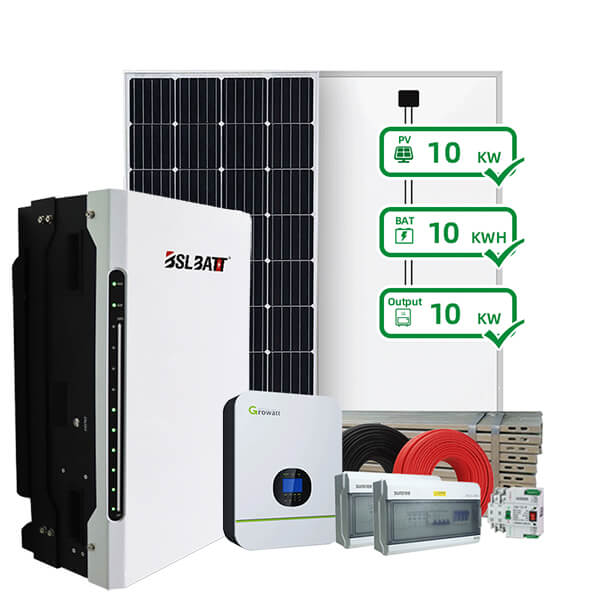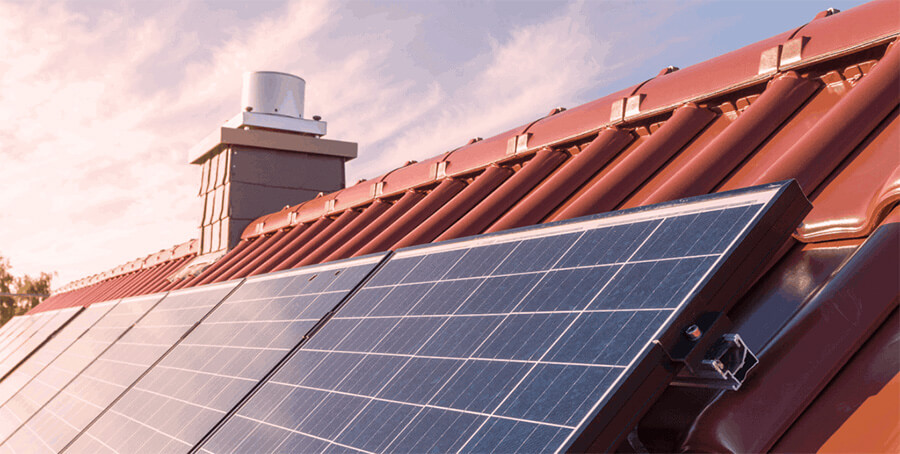Today, photovoltaic applications have become a widely used alternative source of electrical energy. Your home solar battery pack may be one of the more expensive components in a photovoltaic system. How to protect the photovoltaic installation to reduce the cost of use? This is something that every photovoltaic system homeowner needs to worry about!  Generally speaking, photovoltaic installations consist of 4 basic elements: Photovoltaic panels:convert solar energy into electricity. Electrical protection:They keep the photovoltaic installation safe. Photovoltaic inverter:converts direct current into alternating current. Solar battery backup for home:Store excess energy for later use, such as at night or when it is cloudy. BSLBATT introduces you to 7 ways to protect photovoltaic systems >> Selection of DC protection components These components must provide the system with overload, overvoltage, and/or direct voltage and current (DC) short-circuit protection. The configuration will depend on the type and size of the system, always considering two basic factors: 1. The total voltage generated by the photovoltaic system. 2. The nominal current that will flow through each string. With these standards in mind, a protection device must be selected that can withstand the maximum voltage generated by the system and must be sufficient to interrupt or open the circuit when the maximum current expected by the line is exceeded. >> breaker Like other electrical devices, circuit breakers provide over-current and short-circuit protection. The main feature of the DC magnetothermal switch is that its design concept can withstand a DC voltage of up to 1,500 V. The system voltage is determined by the photovoltaic panel string, which is usually the limit of the inverter itself. Generally speaking, the voltage supported by a switch is determined by the number of modules that compose it. Usually, each module supports at least 250 VDC, so if we talk about a 4-module switch, it will be designed to withstand a voltage of up to 1,000 VDC.
Generally speaking, photovoltaic installations consist of 4 basic elements: Photovoltaic panels:convert solar energy into electricity. Electrical protection:They keep the photovoltaic installation safe. Photovoltaic inverter:converts direct current into alternating current. Solar battery backup for home:Store excess energy for later use, such as at night or when it is cloudy. BSLBATT introduces you to 7 ways to protect photovoltaic systems >> Selection of DC protection components These components must provide the system with overload, overvoltage, and/or direct voltage and current (DC) short-circuit protection. The configuration will depend on the type and size of the system, always considering two basic factors: 1. The total voltage generated by the photovoltaic system. 2. The nominal current that will flow through each string. With these standards in mind, a protection device must be selected that can withstand the maximum voltage generated by the system and must be sufficient to interrupt or open the circuit when the maximum current expected by the line is exceeded. >> breaker Like other electrical devices, circuit breakers provide over-current and short-circuit protection. The main feature of the DC magnetothermal switch is that its design concept can withstand a DC voltage of up to 1,500 V. The system voltage is determined by the photovoltaic panel string, which is usually the limit of the inverter itself. Generally speaking, the voltage supported by a switch is determined by the number of modules that compose it. Usually, each module supports at least 250 VDC, so if we talk about a 4-module switch, it will be designed to withstand a voltage of up to 1,000 VDC.  >> Fuse protection Like the magneto-thermal switch, the fuse is a control element to prevent overcurrent, thereby protecting the photovoltaic device. The main difference of circuit breakers is their service life, in this case, when they are subjected to a higher strength than the nominal strength, they are forced to be replaced. The selection of the fuse must conform to the current and maximum voltage of the system. These installed fuses use specific trip curves for these applications called gPV. >> Load disconnect switch In order to have a cut-off element on the DC side, the above-mentioned fuse must be equipped with an isolating switch, allowing it to be cut off before any intervention, providing a high degree of safety and isolation reliability in this part of the installation.. Therefore, they are additional components to protect themselves, and like these, they must be sized according to the installed voltage and current. >> Surge protection Photovoltaic panels and inverters are usually highly exposed to atmospheric phenomena such as lightning strikes, which may cause damage to personnel and equipment. Therefore, it is necessary to install a transient surge arrester, whose role is to transfer the induced energy in the line due to overvoltage (for example, the effect of lightning) to the ground. When selecting protection equipment, it must be considered that the expected maximum voltage in the system is lower than the operating voltage (Uc) of the arrester. For example, if we want to protect a string with a maximum voltage of 500 VDC, a lightning arrester with voltage Up = 600 VDC is sufficient. The arrester must be connected in parallel with the electrical device, connect the + and-poles at the input end of the arrester, and connect the output to the ground terminal. In this way, in the event of an overvoltage, it can be ensured that the discharge induced in any one of the two poles is led out to the ground through the varistor. >> Shell For these applications, these protective devices must be installed in a tested and certified enclosure. In addition, it is recommended that these enclosures can withstand severe weather conditions as they are usually installed outdoors. According to the installation needs, there are different versions of the housing, you can choose different materials (plastic, glass fiber), different working voltage levels (up to 1,500 VDC), and different protection levels (the most common IP65 and IP66). >> Don’t run out of your solar battery pack Home solar lithium battery bank are designed to store excess energy for later use, such as at night or when it is cloudy. But the more you use the battery pack, the sooner it starts to drain. The first key to extending battery life is to avoid completely depleting the battery pack. Your batteries will cycle regularly (a cycle is the battery is fully discharged and charged) because you use them to power your home. A deeper cycle (full discharge) will reduce the capacity and life of the solar lithium battery bank. Designed to keep the capacity of your home solar batteries at 50% or higher. >> Protect your solar battery pack from extreme temperatures The operating temperature range of lithium solar battery bank is 32°F (0°C)-131°F (55°C). They can be stored and discharged under the upper and lower temperature limits. The lithium-ion solar battery cannot be charged at temperatures below freezing point.
>> Fuse protection Like the magneto-thermal switch, the fuse is a control element to prevent overcurrent, thereby protecting the photovoltaic device. The main difference of circuit breakers is their service life, in this case, when they are subjected to a higher strength than the nominal strength, they are forced to be replaced. The selection of the fuse must conform to the current and maximum voltage of the system. These installed fuses use specific trip curves for these applications called gPV. >> Load disconnect switch In order to have a cut-off element on the DC side, the above-mentioned fuse must be equipped with an isolating switch, allowing it to be cut off before any intervention, providing a high degree of safety and isolation reliability in this part of the installation.. Therefore, they are additional components to protect themselves, and like these, they must be sized according to the installed voltage and current. >> Surge protection Photovoltaic panels and inverters are usually highly exposed to atmospheric phenomena such as lightning strikes, which may cause damage to personnel and equipment. Therefore, it is necessary to install a transient surge arrester, whose role is to transfer the induced energy in the line due to overvoltage (for example, the effect of lightning) to the ground. When selecting protection equipment, it must be considered that the expected maximum voltage in the system is lower than the operating voltage (Uc) of the arrester. For example, if we want to protect a string with a maximum voltage of 500 VDC, a lightning arrester with voltage Up = 600 VDC is sufficient. The arrester must be connected in parallel with the electrical device, connect the + and-poles at the input end of the arrester, and connect the output to the ground terminal. In this way, in the event of an overvoltage, it can be ensured that the discharge induced in any one of the two poles is led out to the ground through the varistor. >> Shell For these applications, these protective devices must be installed in a tested and certified enclosure. In addition, it is recommended that these enclosures can withstand severe weather conditions as they are usually installed outdoors. According to the installation needs, there are different versions of the housing, you can choose different materials (plastic, glass fiber), different working voltage levels (up to 1,500 VDC), and different protection levels (the most common IP65 and IP66). >> Don’t run out of your solar battery pack Home solar lithium battery bank are designed to store excess energy for later use, such as at night or when it is cloudy. But the more you use the battery pack, the sooner it starts to drain. The first key to extending battery life is to avoid completely depleting the battery pack. Your batteries will cycle regularly (a cycle is the battery is fully discharged and charged) because you use them to power your home. A deeper cycle (full discharge) will reduce the capacity and life of the solar lithium battery bank. Designed to keep the capacity of your home solar batteries at 50% or higher. >> Protect your solar battery pack from extreme temperatures The operating temperature range of lithium solar battery bank is 32°F (0°C)-131°F (55°C). They can be stored and discharged under the upper and lower temperature limits. The lithium-ion solar battery cannot be charged at temperatures below freezing point.  In order to prolong the service life of the battery pack, please protect it from extremely high temperatures, and do not let it be placed outdoors in the cold. If your batteries become too hot or too cold, they may not be able to achieve as many lifetimes charging cycles as in other situations. >> Lithium-ion solar batteries should not be stored for a long time Lithium ion solar batteries should not be stored for a long time, whether they are empty or fully charged. The optimal storage conditions determined in a large number of experiments are 40% to 50% capacity and at a low temperature of not less than 0°C. Best maintained at 5°C to 10°C. Due to self-discharge, it needs to be recharged every 12 months at the latest. If you find any problems with your photovoltaic system or home lithium solar batteries, please deal with them immediately to prevent additional damage to your solar power system.Contact us to get the latest off-grid solar system solutions from BSLBATT for free!
In order to prolong the service life of the battery pack, please protect it from extremely high temperatures, and do not let it be placed outdoors in the cold. If your batteries become too hot or too cold, they may not be able to achieve as many lifetimes charging cycles as in other situations. >> Lithium-ion solar batteries should not be stored for a long time Lithium ion solar batteries should not be stored for a long time, whether they are empty or fully charged. The optimal storage conditions determined in a large number of experiments are 40% to 50% capacity and at a low temperature of not less than 0°C. Best maintained at 5°C to 10°C. Due to self-discharge, it needs to be recharged every 12 months at the latest. If you find any problems with your photovoltaic system or home lithium solar batteries, please deal with them immediately to prevent additional damage to your solar power system.Contact us to get the latest off-grid solar system solutions from BSLBATT for free!
Post time: May-08-2024








